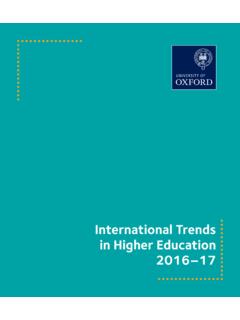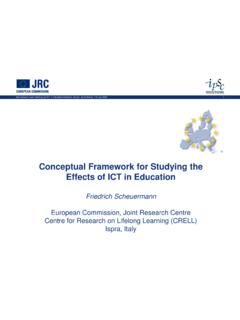Transcription of Measuring Innovation in Education Québec, Canada ...
1 Measuring Innovation in Education Qu bec, Canada educational system Note In this system note: Background on the 2014 OECD Measurement of Innovation in Education report (p. 1). Key report findings on Innovation in Education (p. 1). Report approach to Measuring educational system Innovation (p. 2). Qu bec's top organisational Education innovations, 2003-2011 (p. 3). Qu bec's top pedagogic Education innovations, 2003-2011 (p. 4). The purpose of the Measuring Innovation in Education report The ability to measure Innovation is essential to an improvement strategy in Education . Knowing whether, and how much, practices are changing within classrooms and educational organisations, how teachers develop and use their pedagogical resources, and to what extent change can be linked to improvements would provide a substantial increase in the international Education knowledge base.
2 The OECD Measuring Innovation in Education report offers new perspectives to address this need for measurement in educational Innovation through a comparison of Innovation in Education to Innovation in other sectors, identification of specific innovations across educational systems, and construction of metrics to examine the relationship between educational Innovation and changes in educational outcomes. This brief provides a short overview of the key findings of the report, as well as the top pedagogic and organisational innovations in Qu bec ( Canada ) identified by this report. Key findings on Innovation in Education did you know? Overall composite Innovation index, 2000-2011. Overall Innovation 40.
3 35. 30. 25. 20. 15. 10. 5. 0. MIE Figure In Education , Innovation can take place through either significant change in the use of a particular educational practice or the emergence of new practices in an educational system . Contrary to common belief, there is a fair level of Innovation in the Education sector, both relative to other sectors and in absolute terms. Within Education , Innovation intensity is greatest in higher Education , with secondary and primary Education approximately equal. Compared to other sectors, knowledge and method Innovation is above average in Education , product and service Innovation is below average, and technology Innovation is at the average sectorial level. In Europe, higher Education stands out in terms of speed of adopting Innovation compared to the economy average as well as the rates in primary and secondary Education .
4 1. Measuring Innovation in Education Qu bec, Canada educational system Note There have been large increases in innovative pedagogic practices across all countries studied for this report in areas such as relating lessons to real life, higher order skills, data and text interpretation and personalisation of teaching. In their pedagogic practice, educators have innovated in their use of assessments and in the accessibility and use of support resources for instruction. educational organisations have innovated in the areas of special Education , creation of professional learning communities for teachers, evaluation and analytics and relationship building with external stakeholders, such as parents. In general, countries with greater levels of Innovation see increases in certain educational outcomes, including higher (and improving) 8th grade mathematics performance, more equitable learning outcomes across ability and more satisfied teachers.
5 Innovative educational systems generally have higher expenditures than non-innovative systems;. however, their students are no more satisfied than those in less innovative systems. Approach to Measuring system innovations While Measuring Innovation in Education identifies and analyses hundreds of innovations at the classroom and organisational levels, this brief identifies the top innovations in pedagogic and organisational practices in Qu bec between 2003 and 2011. To determine each educational system 's top innovations in pedagogic and organisational practices, data from three international Education datasets Trends in International Mathematics and Science Study (TIMSS), Progress in International Reading Literacy Study (PIRLS), and the Programme on International Student Assessment (PISA) were analysed to identify the areas in which each Education system has demonstrated emerging or changing organisational and pedagogic practices over a specific period.
6 For a full description of the data and methods used for analysis in this report, see report Annex A: Data Sources and Methods. Please cite this publication as: OECD (2014), Measuring Innovation in Education : A New Perspective, educational Research and Innovation , OECD Publishing. This work is published under the responsibility of the Secretary-General of the OECD. The opinions expressed and arguments employed herein do not necessarily reflect the official views of OECD member countries. This document and any map included herein are without prejudice to the status of or sovereignty over any territory, to the delimitation of international frontiers and boundaries and to the name of any territory, city or area.
7 OECD 2014. You can copy, download or print OECD content for your own use, and you can include excerpts from OECD publications, databases and multimedia products in your own documents, presentations, blogs, websites and teaching materials, provided that suitable acknowledgment of OECD as source and copyright owner is given. All requests for commercial use and translation rights should be submitted to Note regarding data from Israel The statistical data for Israel are supplied by and are under the responsibility of the relevant Israeli authorities. The use of such data by the OECD is without prejudice to the status of the Golan Heights, East Jerusalem and Israeli settlements in the West Bank under the terms of international law.
8 Country Note Authors: Questions can be directed to: Dara Fisher St phan Vincent-Lancrin St phan Vincent-Lancrin 2. Measuring Innovation in Education Qu bec, Canada educational system Note Qu bec's top innovations in organisational policy and practice: (1) More external evaluation of primary and secondary school classrooms . Primary and secondary schools in Qu bec underwent more frequent observations of teachers' practices by inspectors or other persons external to the school. In 2003, the percentage of students in schools in which observations by external evaluators were used was less than 1% for 8th grade math, 8th grade science, and 4th grade classrooms; by 2011, these practices were being used in the classrooms of of 8th grade math students, of 8th grade science students, and of 4th grade students.
9 (2) More enrichment Education for primary science students . Another top organisational Innovation in primary schools in Qu bec is the increased availability of enrichment Education for 4th grade science students. Between 2003 and 2007, the percentage of 4th grade students in Qu bec enrolled in schools offering enrichment activities in science increased by 13% points, the second- largest increase of countries analysed for this metric. The OECD mean difference in availability of primary school science enrichment reflected no change over the specified time period. (3) More remedial mathematics and science Education in primary schools . Percentage of 4th grade students in schools that offer remedial science and change over time 2003 2007 Negative change Positive change OECD (average absolute change).
10 %. -12 -9 -3 -3 -2 -2 -1 -0 +0 +1 +1 +5 +7 +10 +12 +13 % point 100 16. 90 14. 80. 12. 70. 60 10. 50 8. 40 6. 30. 4. 20. 10 2. 0 0. MIE Figure The increased availability of remedial Education in math and science at the primary school level is another notable Innovation in Qu bec's educational system . Between 2003 and 2007, the proportion of 4th grade students in Qu bec in schools that offer remedial mathematics Education rose by 16% points; over the same period, the percentage of students in schools that offer remedial science Education increased by 12% points. Of the systems analysed in this report, only the Russian Federation had larger gains in these educational areas, with increases of 26% points and 13% points in remedial math and science, respectively.
















